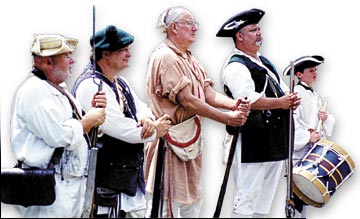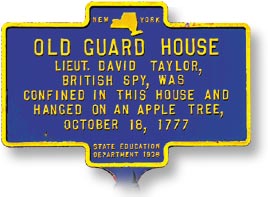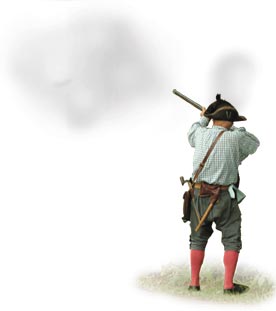|
|
We are sorry to announce that Stone House Day IS NOT BEING HELD until further notice. |
|
“Stone House Day” Hamlet Recalls 1666 “Awe, Terror”
Old Hurley, a Convicted of “taking of arms in a riotous and illegal manner upon the 16th of Febr. 1666, to awe, terrify and suppress His Majesty’s English Garrison established at Esopus—they deserved to be put to death,” the court decided. Instead, a lenient English governor banished the leader from the Government “for life” with 48 hours to take all his belongings with him. His co-terrorist son was banished for “a year and a day” but could stay for 40 days “till his corn is husked, threshed and disposed of.” Later, his father’s sentence was remitted to half his time, (half a lifetime?), and he could remain anyplace in the “Government” except Esopus, New York and Albany. Another English governor in 1669 ordered “Nieuw Dorp” to be renamed “Hurley” after his ancestral estate in Hurley, England, on the Thames near London, and “Esopus” became Kingston.
The old Dutch village today boasts 25 stone houses,
Five to eight residents each year open their venerable stone homes to visitors on Stone House Day, on Among the open houses every year is the 1740 Van Deusen House, the temporary capital of New York after the British torched Kingston in October 1777, and the 1685 Spy House where a British spy was held before being hanged on an apple tree across the street in retaliation for Kingston’s destruction.
Kingston had been burned 114 years earlier, that time by Indians who, in a coordinated attack, set fire to all the homes in Hurley, killing several men and taking 39 women and children captive. The hostages were all rescued unharmed months later, abandoned by their captors with the approach of Dutch troops from the local area and from Manhattan. However, one young woman, having married a brave, declined to be rescued.
A year after the burning of the village came another calamity. The despised English took over the entire Dutch colony of New Amsterdam in a bloodless victory and the same day renamed it New York. Though the military occupiers were under orders to let the Dutch govern themselves, to “avoid harshness of words and heat of passion,” and to avoid being prejudiced against the Dutch, in Hurley, a cruel Captain Brodhead allowed his soldiers to take brutal steps against their victims, and he himself was party to various infamous actions. The English abominations led to the accusations of a Dutch mutiny to “awe, terrify and suppress” their tormentors. (Condemned to death, the “mutineers” later were allowed back to the area, and the leader again became a respected local official). Undaunted, the Dutch started rebuilding their homes in durable stone and Hurley’s Main Street has become a feature on the State’s Revolutionary War Heritage Trail and a National Historic Landmark, the highest Federal designation of historic sites.
Stone House Day has endured for over All homes on the tour are different and all interesting. Patentee Manor and the 1708 TenEyck Bouwerie, like the VanDeusen house, show antique furniture. The Spy House is more eclectic, with Victorian pieces handed down for several generations as well as later 20th century furnishings. Legend has it that the Ten Eyck dwelling on Main Street, also open, was once a stop on the Underground Railway before the Civil War, with a tunnel running to the church across the street; but no evidence of it has been uncovered.
One of the stone homes has become the village’s Museum and it will be open Stone House Day along with the Ulster County Genealogical Society which has its offices in the 1853 classic white church. The Society attracts many visitors trying to trace their Dutch lineage and the Stone House Day also offers a number of free attractions: a Revolutionary War military encampment, an “18th century” music group, the annual Library Fair with hundreds of books for sale at ridiculously low prices. Also to be enjoyed are craft sales and food in the cafeteria at the church.
The homes on Main Street are all within a 150-yard walking distance, and most are accessible with one or two steps or ramps. Each house has its own costumed guides so visitors may spend as little or as much time as they wish in each house. Tour hours are
For those who can spend more than a day in the Mid-Hudson Valley, numerous sight-seeing possibilities are offered ten minutes to an hour away: the Victorian resort at Lake Mohonk, a National Historic Landmark; the Maritime Museum, the Senate House and Hudson River Cruises in Kingston; Hyde Park, Franklin Delano Roosevelt’s home; the Vanderbilt mansion and others estates of wealthy industrialists; Woodstock, the Catskills, and the Ashokan Reservoir; Huguenot Street in New Paltz; and a grandly-restored Kingston City Hall, a replica of an Italian doge’s palace; Kingston also offers its “Historic Trolley”-style bus ride around the
Hurley is four minutes from NYS Thruway (I-87) Exit 19 at Kingston, on Route 209 South toward Ellenville—two hours from New York’s 42nd Street, an hour from Albany or northern New Jersey, 2½ hours from Springfield, Massachusetts, and three hours from Allentown, Pennsylvania. Parking is free, as are tours for children
Tickets:
House tours are For further information, contact:
The date is always
Although Stone House Day is arranged by the church, it has become a community project with several organizations and many neighbors volunteering their help.
|


